2008 CHRYSLER TOWN AND COUNTRY coolant level
[x] Cancel search: coolant levelPage 321 of 531
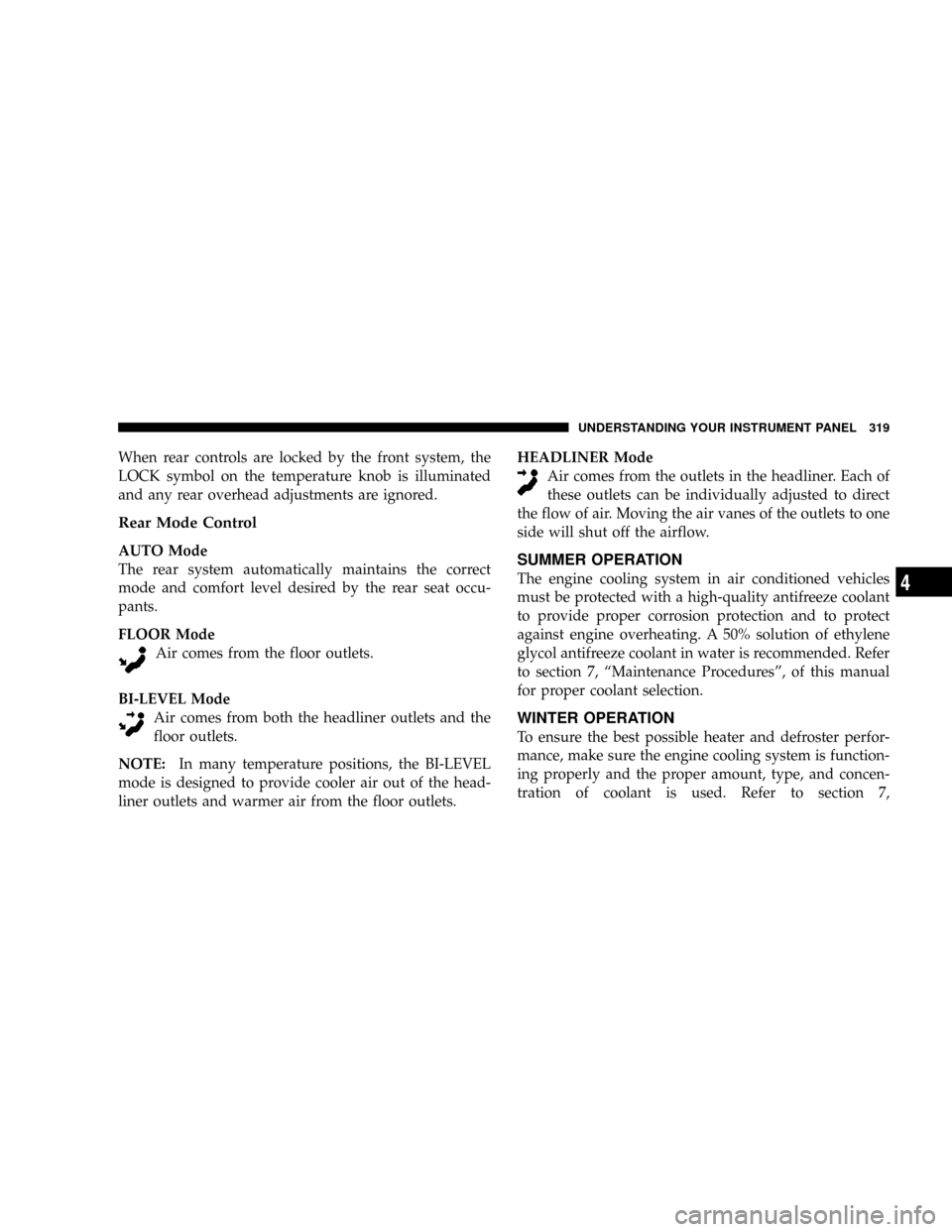
When rear controls are locked by the front system, the
LOCK symbol on the temperature knob is illuminated
and any rear overhead adjustments are ignored.
Rear Mode Control
AUTO Mode
The rear system automatically maintains the correct
mode and comfort level desired by the rear seat occu-
pants.
FLOOR Mode
Air comes from the floor outlets.
BI-LEVEL Mode
Air comes from both the headliner outlets and the
floor outlets.
NOTE:In many temperature positions, the BI-LEVEL
mode is designed to provide cooler air out of the head-
liner outlets and warmer air from the floor outlets.HEADLINER Mode
Air comes from the outlets in the headliner. Each of
these outlets can be individually adjusted to direct
the flow of air. Moving the air vanes of the outlets to one
side will shut off the airflow.SUMMER OPERATION
The engine cooling system in air conditioned vehicles
must be protected with a high-quality antifreeze coolant
to provide proper corrosion protection and to protect
against engine overheating. A 50% solution of ethylene
glycol antifreeze coolant in water is recommended. Refer
to section 7, ªMaintenance Proceduresº, of this manual
for proper coolant selection.
WINTER OPERATION
To ensure the best possible heater and defroster perfor-
mance, make sure the engine cooling system is function-
ing properly and the proper amount, type, and concen-
tration of coolant is used. Refer to section 7,
UNDERSTANDING YOUR INSTRUMENT PANEL 319
4
Page 458 of 531
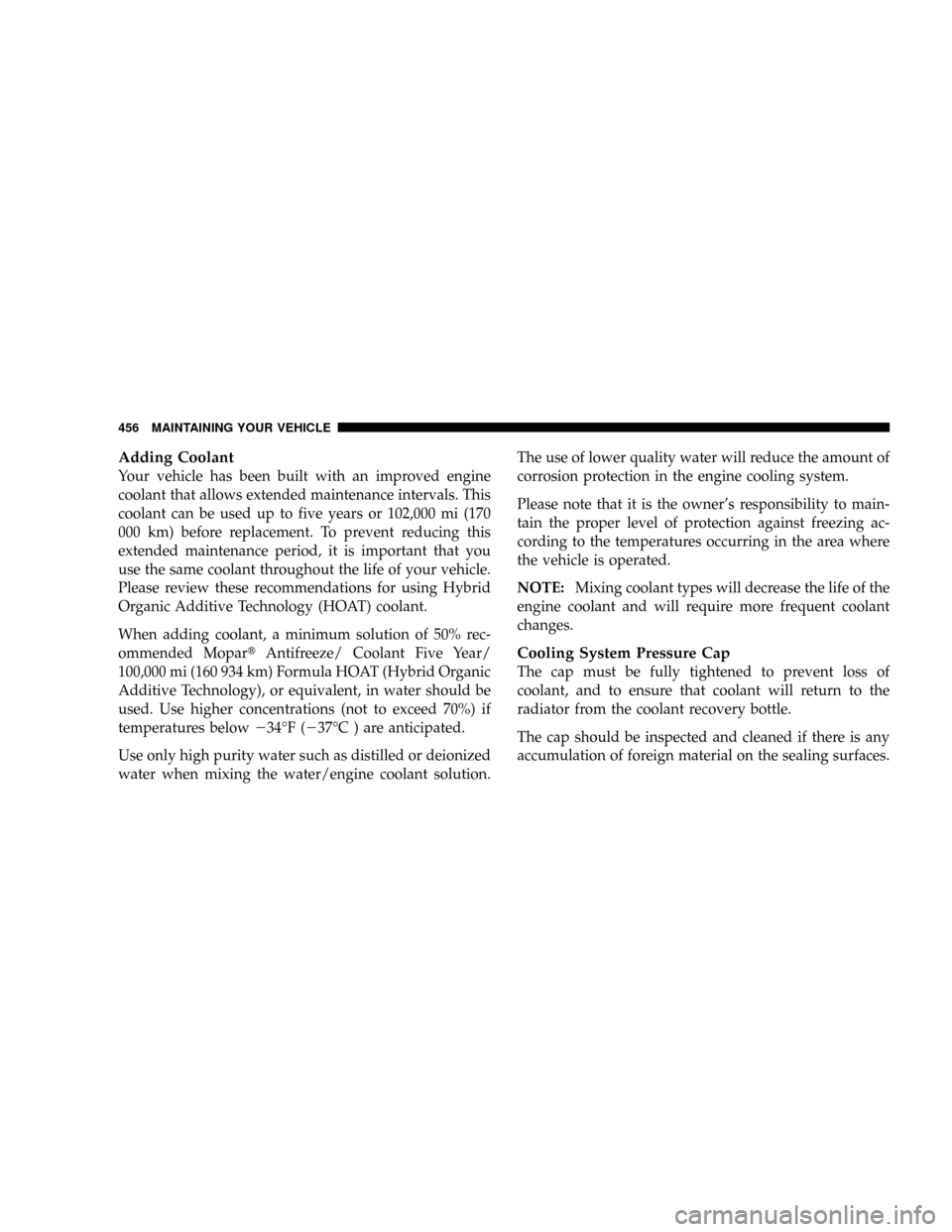
Adding Coolant
Your vehicle has been built with an improved engine
coolant that allows extended maintenance intervals. This
coolant can be used up to five years or 102,000 mi (170
000 km) before replacement. To prevent reducing this
extended maintenance period, it is important that you
use the same coolant throughout the life of your vehicle.
Please review these recommendations for using Hybrid
Organic Additive Technology (HOAT) coolant.
When adding coolant, a minimum solution of 50% rec-
ommended MopartAntifreeze/ Coolant Five Year/
100,000 mi (160 934 km) Formula HOAT (Hybrid Organic
Additive Technology), or equivalent, in water should be
used. Use higher concentrations (not to exceed 70%) if
temperatures below234ÉF (237ÉC ) are anticipated.
Use only high purity water such as distilled or deionized
water when mixing the water/engine coolant solution.The use of lower quality water will reduce the amount of
corrosion protection in the engine cooling system.
Please note that it is the owner's responsibility to main-
tain the proper level of protection against freezing ac-
cording to the temperatures occurring in the area where
the vehicle is operated.
NOTE:Mixing coolant types will decrease the life of the
engine coolant and will require more frequent coolant
changes.
Cooling System Pressure Cap
The cap must be fully tightened to prevent loss of
coolant, and to ensure that coolant will return to the
radiator from the coolant recovery bottle.
The cap should be inspected and cleaned if there is any
accumulation of foreign material on the sealing surfaces.
456 MAINTAINING YOUR VEHICLE
Page 459 of 531
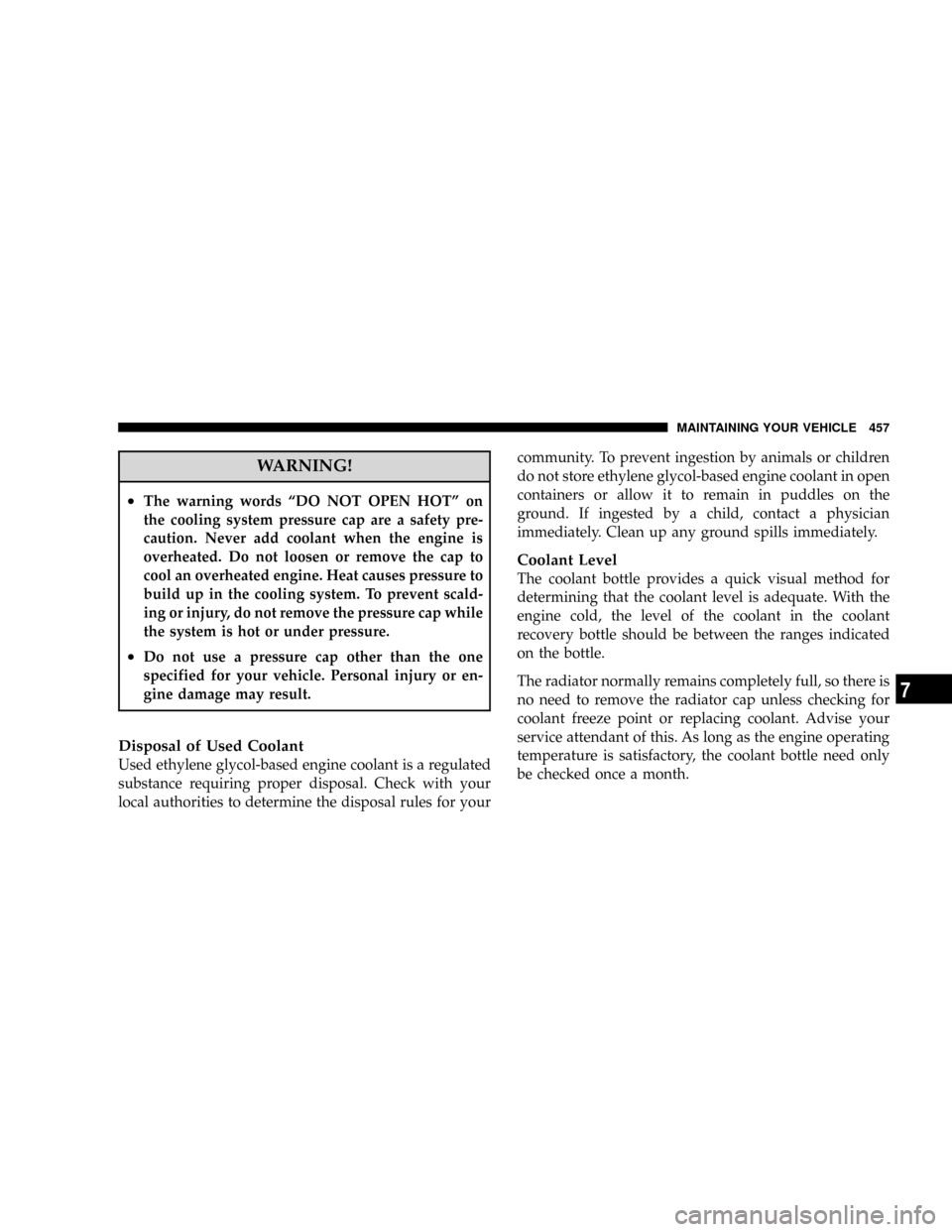
WARNING!
²The warning words ªDO NOT OPEN HOTº on
the cooling system pressure cap are a safety pre-
caution. Never add coolant when the engine is
overheated. Do not loosen or remove the cap to
cool an overheated engine. Heat causes pressure to
build up in the cooling system. To prevent scald-
ing or injury, do not remove the pressure cap while
the system is hot or under pressure.
²Do not use a pressure cap other than the one
specified for your vehicle. Personal injury or en-
gine damage may result.
Disposal of Used Coolant
Used ethylene glycol-based engine coolant is a regulated
substance requiring proper disposal. Check with your
local authorities to determine the disposal rules for yourcommunity. To prevent ingestion by animals or children
do not store ethylene glycol-based engine coolant in open
containers or allow it to remain in puddles on the
ground. If ingested by a child, contact a physician
immediately. Clean up any ground spills immediately.
Coolant Level
The coolant bottle provides a quick visual method for
determining that the coolant level is adequate. With the
engine cold, the level of the coolant in the coolant
recovery bottle should be between the ranges indicated
on the bottle.
The radiator normally remains completely full, so there is
no need to remove the radiator cap unless checking for
coolant freeze point or replacing coolant. Advise your
service attendant of this. As long as the engine operating
temperature is satisfactory, the coolant bottle need only
be checked once a month.
MAINTAINING YOUR VEHICLE 457
7
Page 460 of 531
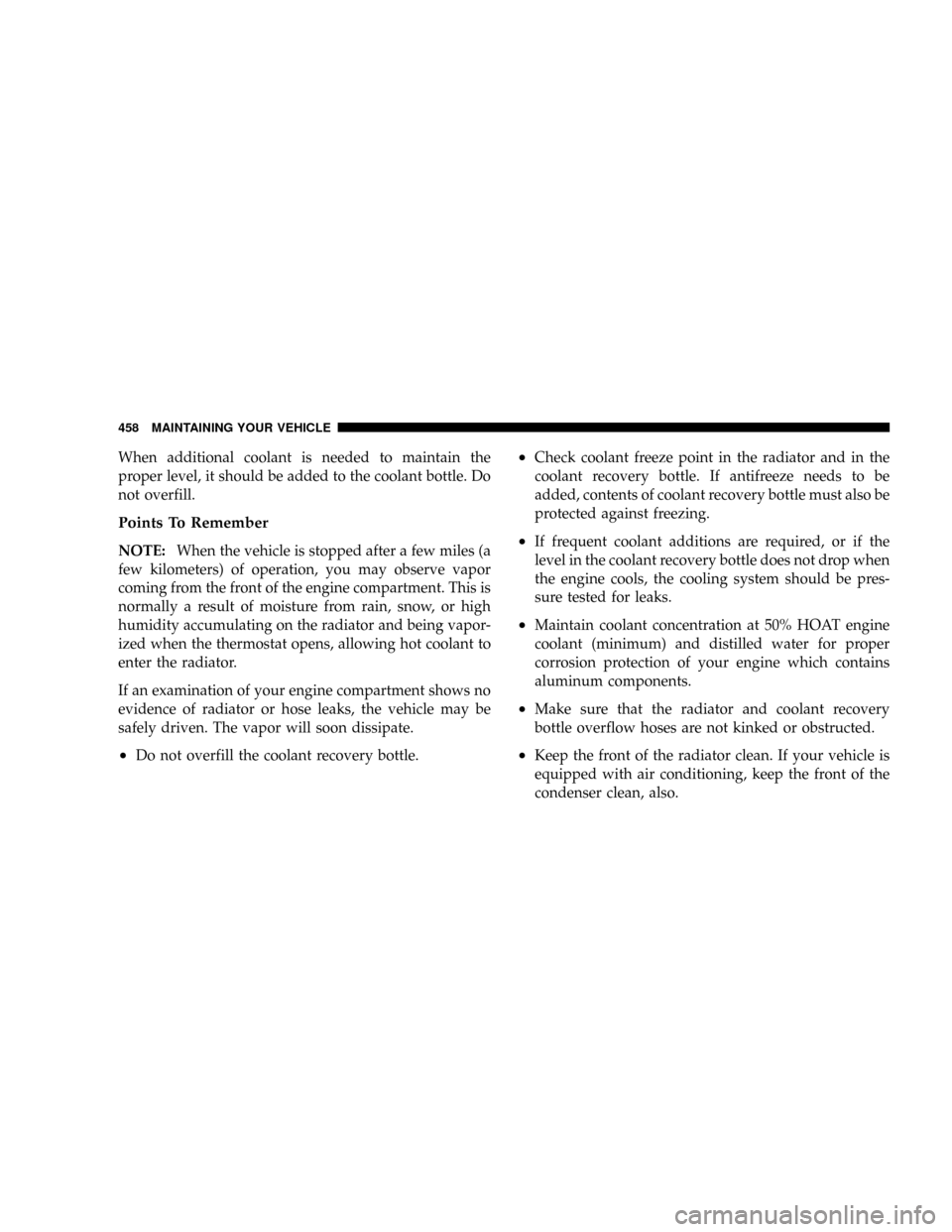
When additional coolant is needed to maintain the
proper level, it should be added to the coolant bottle. Do
not overfill.
Points To Remember
NOTE:When the vehicle is stopped after a few miles (a
few kilometers) of operation, you may observe vapor
coming from the front of the engine compartment. This is
normally a result of moisture from rain, snow, or high
humidity accumulating on the radiator and being vapor-
ized when the thermostat opens, allowing hot coolant to
enter the radiator.
If an examination of your engine compartment shows no
evidence of radiator or hose leaks, the vehicle may be
safely driven. The vapor will soon dissipate.
²Do not overfill the coolant recovery bottle.
²Check coolant freeze point in the radiator and in the
coolant recovery bottle. If antifreeze needs to be
added, contents of coolant recovery bottle must also be
protected against freezing.
²If frequent coolant additions are required, or if the
level in the coolant recovery bottle does not drop when
the engine cools, the cooling system should be pres-
sure tested for leaks.
²Maintain coolant concentration at 50% HOAT engine
coolant (minimum) and distilled water for proper
corrosion protection of your engine which contains
aluminum components.
²Make sure that the radiator and coolant recovery
bottle overflow hoses are not kinked or obstructed.
²Keep the front of the radiator clean. If your vehicle is
equipped with air conditioning, keep the front of the
condenser clean, also.
458 MAINTAINING YOUR VEHICLE
Page 488 of 531
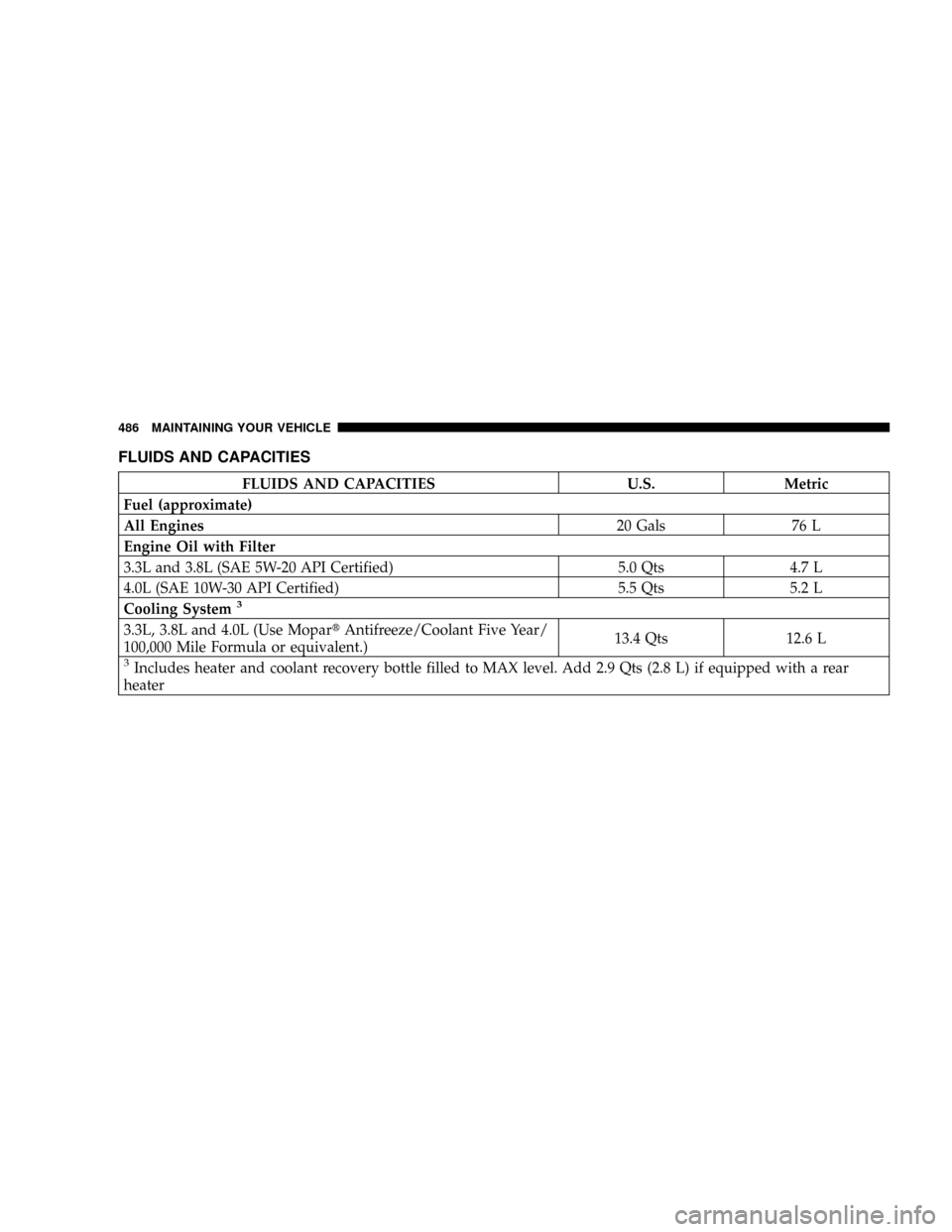
FLUIDS AND CAPACITIES
FLUIDS AND CAPACITIES U.S. Metric
Fuel (approximate)
All Engines20 Gals 76 L
Engine Oil with Filter
3.3L and 3.8L (SAE 5W-20 API Certified) 5.0 Qts 4.7 L
4.0L (SAE 10W-30 API Certified) 5.5 Qts 5.2 L
Cooling System
3
3.3L, 3.8L and 4.0L (Use MopartAntifreeze/Coolant Five Year/
100,000 Mile Formula or equivalent.)13.4 Qts 12.6 L
3Includes heater and coolant recovery bottle filled to MAX level. Add 2.9 Qts (2.8 L) if equipped with a rear
heater
486 MAINTAINING YOUR VEHICLE
Page 494 of 531
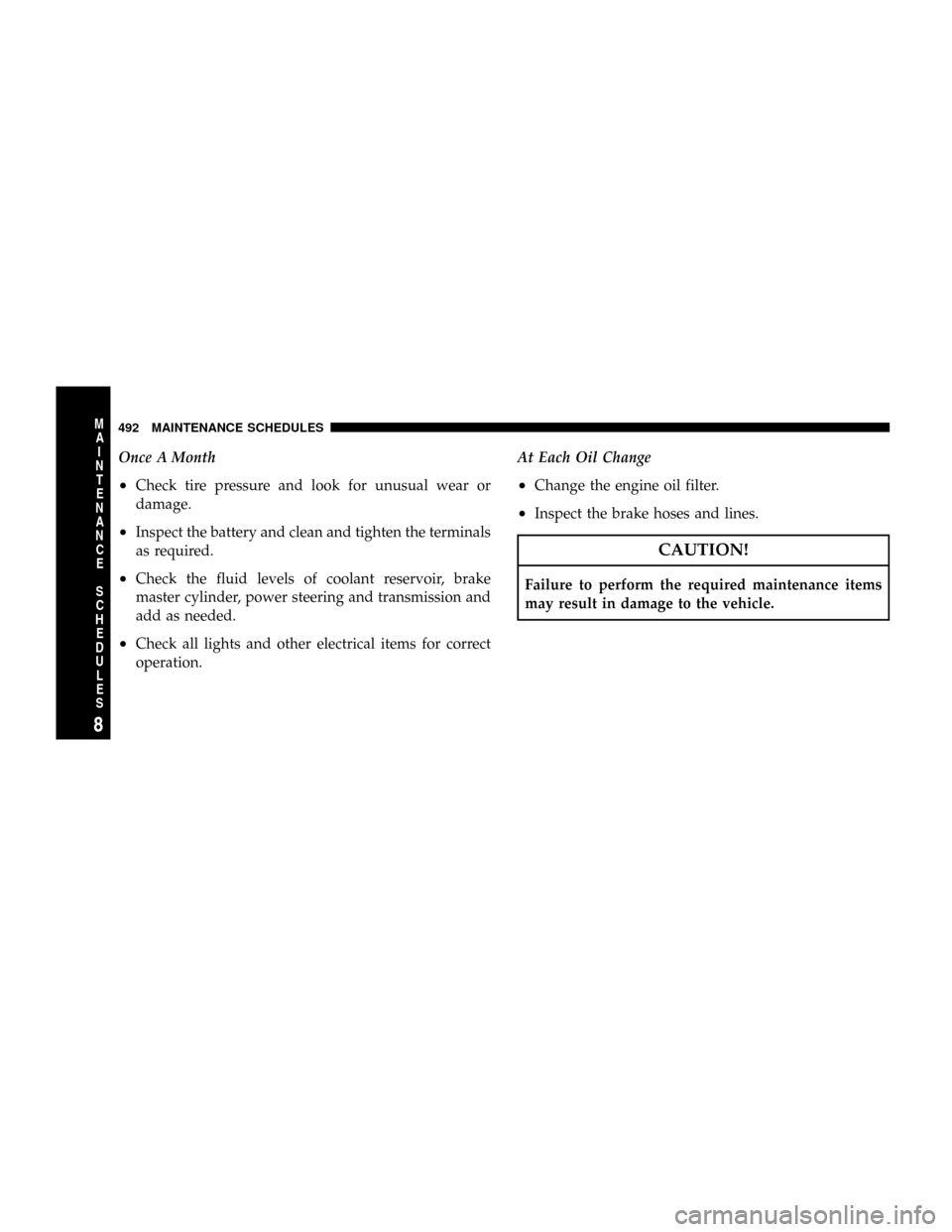
Once A Month
²Check tire pressure and look for unusual wear or
damage.
²Inspect the battery and clean and tighten the terminals
as required.
²Check the fluid levels of coolant reservoir, brake
master cylinder, power steering and transmission and
add as needed.
²Check all lights and other electrical items for correct
operation.At Each Oil Change
²Change the engine oil filter.
²Inspect the brake hoses and lines.
CAUTION!
Failure to perform the required maintenance items
may result in damage to the vehicle.
492 MAINTENANCE SCHEDULES
8
M
A
I
N
T
E
N
A
N
C
E
S
C
H
E
D
U
L
E
S
Page 513 of 531
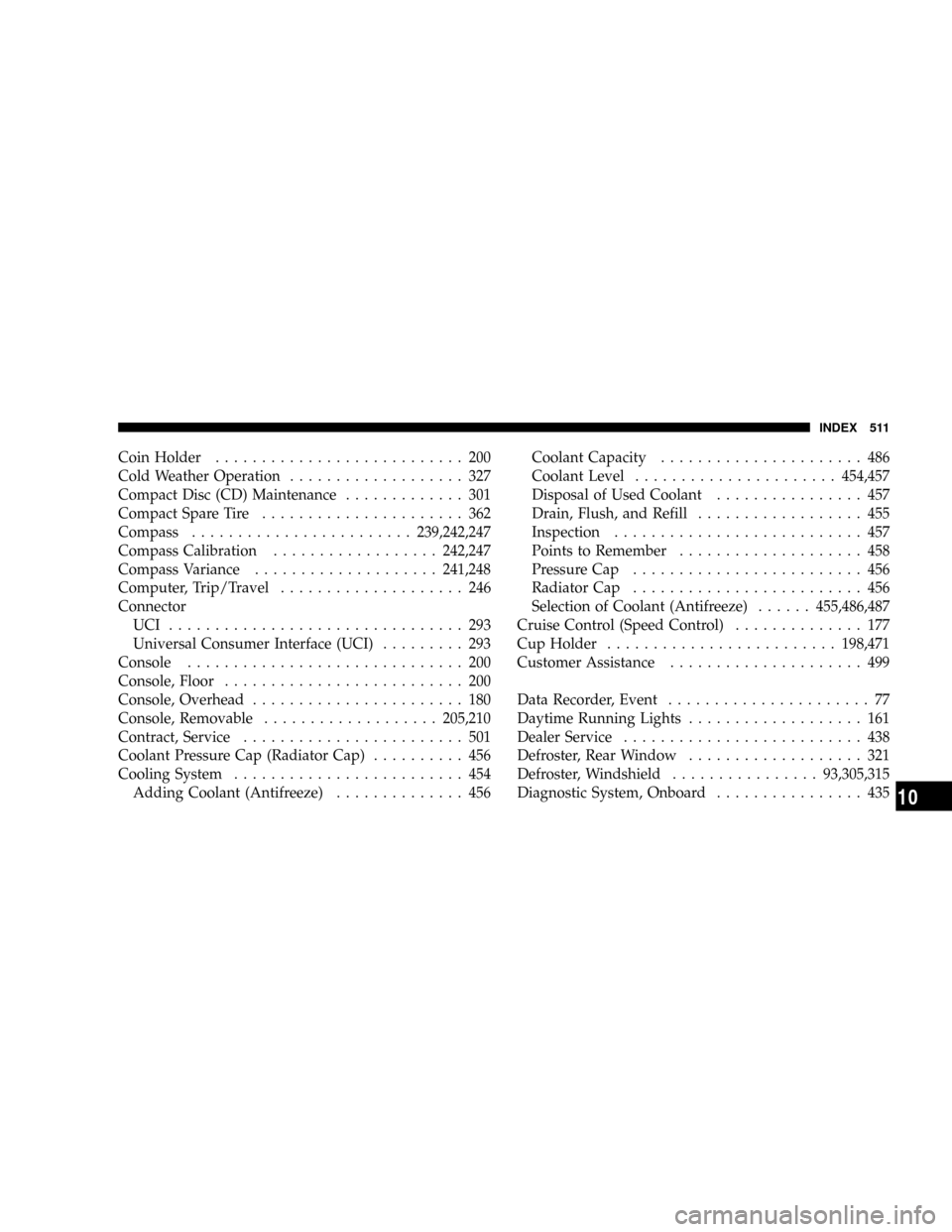
Coin Holder........................... 200
Cold Weather Operation................... 327
Compact Disc (CD) Maintenance............. 301
Compact Spare Tire...................... 362
Compass........................239,242,247
Compass Calibration..................242,247
Compass Variance....................241,248
Computer, Trip/Travel.................... 246
Connector
UCI ................................ 293
Universal Consumer Interface (UCI)......... 293
Console.............................. 200
Console, Floor.......................... 200
Console, Overhead....................... 180
Console, Removable...................205,210
Contract, Service........................ 501
Coolant Pressure Cap (Radiator Cap).......... 456
Cooling System......................... 454
Adding Coolant (Antifreeze).............. 456Coolant Capacity...................... 486
Coolant Level......................454,457
Disposal of Used Coolant................ 457
Drain, Flush, and Refill.................. 455
Inspection........................... 457
Points to Remember.................... 458
Pressure Cap......................... 456
Radiator Cap......................... 456
Selection of Coolant (Antifreeze)......455,486,487
Cruise Control (Speed Control).............. 177
Cup Holder.........................198,471
Customer Assistance..................... 499
Data Recorder, Event...................... 77
Daytime Running Lights................... 161
Dealer Service.......................... 438
Defroster, Rear Window................... 321
Defroster, Windshield................93,305,315
Diagnostic System, Onboard................ 435
INDEX 511
10
Page 515 of 531
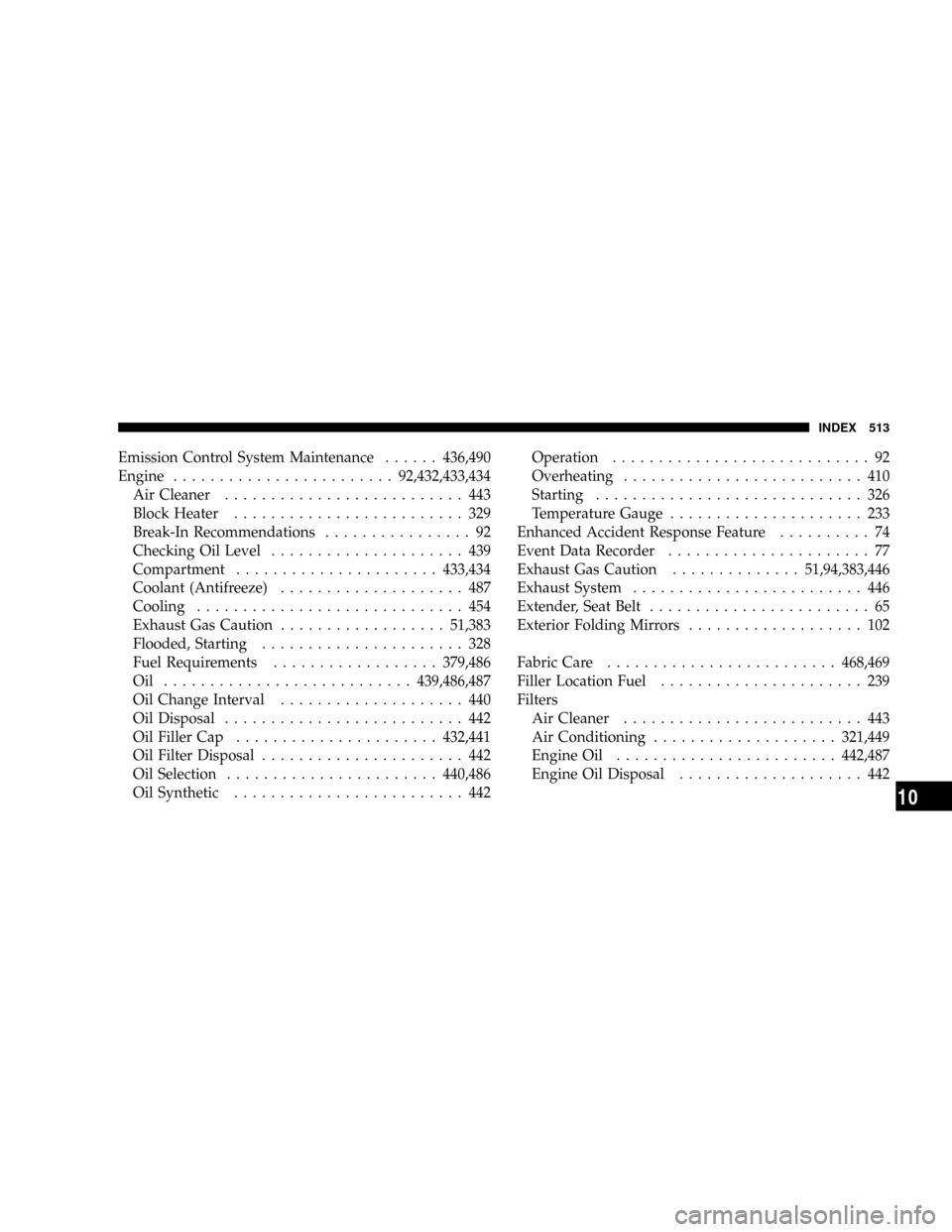
Emission Control System Maintenance......436,490
Engine........................92,432,433,434
Air Cleaner.......................... 443
Block Heater......................... 329
Break-In Recommendations................ 92
Checking Oil Level..................... 439
Compartment......................433,434
Coolant (Antifreeze).................... 487
Cooling............................. 454
Exhaust Gas Caution..................51,383
Flooded, Starting...................... 328
Fuel Requirements..................379,486
Oil ...........................439,486,487
Oil Change Interval.................... 440
Oil Disposal.......................... 442
Oil Filler Cap......................432,441
Oil Filter Disposal...................... 442
Oil Selection.......................440,486
Oil Synthetic......................... 442Operation............................ 92
Overheating.......................... 410
Starting............................. 326
Temperature Gauge..................... 233
Enhanced Accident Response Feature.......... 74
Event Data Recorder...................... 77
Exhaust Gas Caution..............51,94,383,446
Exhaust System......................... 446
Extender, Seat Belt........................ 65
Exterior Folding Mirrors................... 102
Fabric Care.........................468,469
Filler Location Fuel...................... 239
Filters
Air Cleaner.......................... 443
Air Conditioning....................321,449
Engine Oil........................442,487
Engine Oil Disposal.................... 442
INDEX 513
10